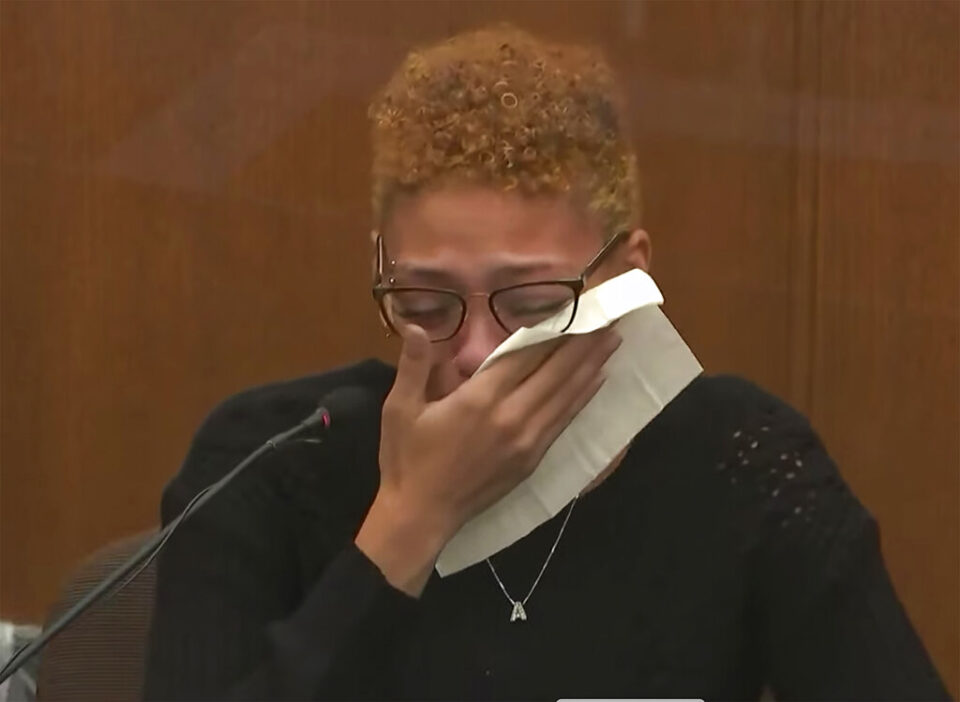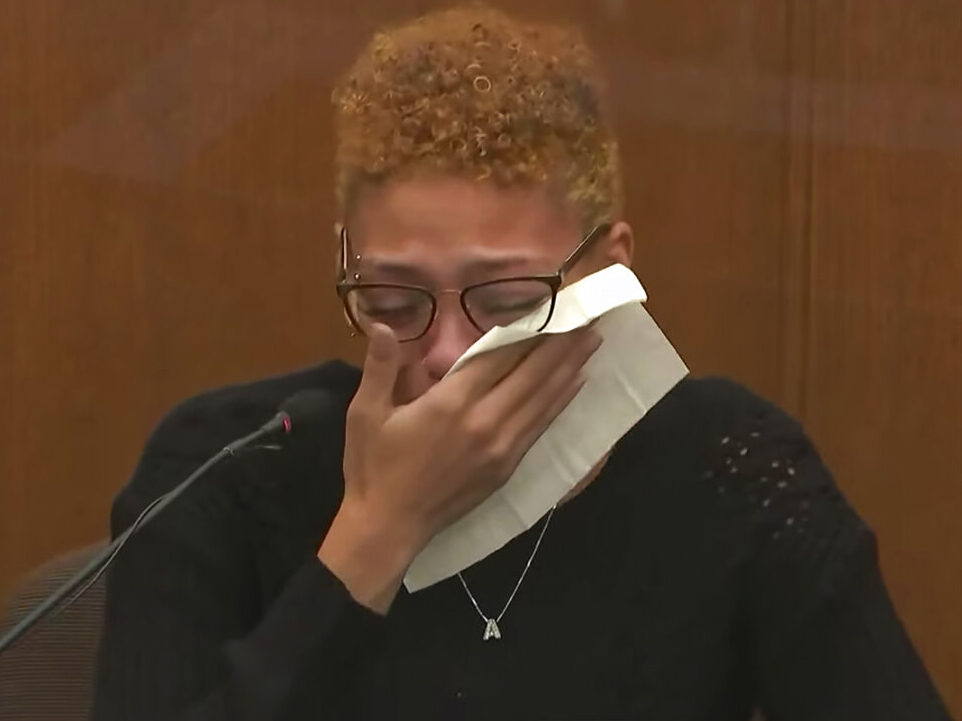
MINNEAPOLIS (AP) — The woman who was riding with Daunte Wright when he was pulled over by police testified Thursday about the chaos right after an officer shot him, saying she screamed at Wright trying to get a response but that he “wasn’t answering me and he was just gasping.”
“I grabbed whatever was in the car. I don’t remember if it was a sweater or a towel or something … and put it on his chest like you see in movies and TV shows,” Alayna Albrecht-Payton, who was Wright’s girlfriend, testified. “I didn’t know what to do.”
Albrecht-Payton answered Wright’s cellphone as his mother tried frantically to reestablish contact after a call with him was cut off right before he was shot. Wright’s mother, Katie Bryant, testified tearfully on Wednesday that she first saw her son’s apparently lifeless body via that video call.
“I pointed the camera on him,” Albrecht-Payton said. “And I’m so sorry I did that.”
Kim Potter, 49, is charged with first-degree and second-degree manslaughter in Wright’s April 11 death in Brooklyn Center. The white former officer — she resigned two days after the shooting — has said she meant to use her Taser on the 20-year-old Wright, who was Black, after he attempted to drive away from a traffic stop as officers tried to arrest him, but that she grabbed her handgun instead.
Albrecht-Payton, 20, took the stand on the second day of testimony, after opening statements Wednesday in which prosecutors portrayed Potter as a veteran cop who had been repeatedly trained in Taser use, with warnings about avoiding such deadly mix-ups.
The defense countered that Potter had simply made an error. Attorney Paul Engh also said Wright might have averted tragedy if he had surrendered to Potter and the other officers at the scene.
Defense attorney Earl Gray pressed Albrecht-Payton on Wright’s actions immediately after Potter shot him, in an apparent attempt to show that Wright deliberately tried to drive away even while gravely wounded.
Albrecht-Payton said Wright’s hands “were never on the wheel” and that the car moved away from the scene because his foot was on the gas.
Gray also questioned Albrecht-Payton about the couple’s activities before the traffic stop. She testified that they had smoked marijuana that day.
The jury was shown police videos that showed the scene after Wright’s vehicle slammed into another car. The collision was captured by the dashcam of Officer Alan Salvosa’s police car, which was behind the car when Wright’s vehicle struck it.
Salvosa’s body camera showed him calling for aid as he drew his weapon and repeatedly ordered “Put your hands up!” to the occupants of Wright’s car. The passenger — Albrecht-Payton — is heard saying “I can’t.” Salvosa testified that he couldn’t see into the rear of the car, which he knew had just left a location where officers were seeking to make an arrest.
As Salvosa waited for backup and ambulances, about 8 1/2 minutes passed from the moment of the crash before officers moved in to begin trying to help Wright. Salvosa’s body camera footage shows that officers at the scene of the crash did not immediately know that Wright had been shot.
In her opening statement, prosecutor Erin Eldridge told the jury that after Potter shot Wright, she didn’t try to render aid and didn’t immediately call in the shooting. She said this meant that officers approaching his crashed vehicle “didn’t know what they were dealing with” and waited for almost 10 minutes before they “dragged Dante Wright’s dead body out of the car.”
Prosecutors on Thursday also called the wife and the daughter of a man who was in the car struck by Wright’s to testify about the toll the crash took on the man’s health. Denise Lundgren Wells testified that her father, Kenneth Lundgren, had health issues before the crash but that his decline accelerated afterward. He is now in his 80s and in hospice care, she testified.
Video dominated the first day of testimony, with officers’ body cameras and a different police dashcam that showed Potter threatening to shoot Wright with a Taser as another officer tried to pull him out of his car. After she shot him with her gun, Potter can be heard saying, “I just shot him. … I grabbed the wrong (expletive) gun!”
A mostly white jury was seated last week in the case, which sparked angry demonstrations outside the Brooklyn Center police station last spring just as former Minneapolis Officer Derek Chauvin was on trial 10 miles (16 kilometers) away for killing George Floyd.
The defense says Potter made a mistake when she grabbed the wrong weapon and shot Wright. But they also say that she would have been justified in using deadly force because Wright was about to drive away with one or both of Wright’s fellow officers endangered.
The charges don’t require proof that Potter intended to kill Wright.
Potter, who told the court she will testify, was training a new officer when they pulled Wright over for having expired license plate tags and an air freshener hanging from the rearview mirror.
The most serious charge against Potter requires prosecutors to prove recklessness, while the lesser requires them to prove culpable negligence. Minnesota’s sentencing guidelines call for a prison term of just over seven years on the first-degree manslaughter count and four years on the second-degree one. Prosecutors have said they will seek a longer sentence.
Gov. Tim Walz said Wednesday that he was preparing the National Guard to help with security if needed after the verdict.

